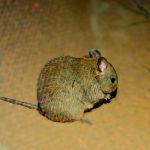GREATER STICK-NEST RAT
The greater stick-nest rat is a medium-sized rodent, with a body length of about 20 to 25 centimetres, and a tail adding another 15 centimetres. It has a robust build, with soft, dense fur that is typically grey-brown on top and lighter underneath. Its large, round eyes and small, rounded ears give it an endearing appearance, perfectly suited to its nocturnal lifestyle.
These rats are found in the arid and semi-arid regions of Australia. Once widespread, their range has now dwindled, and they are primarily found on islands such as Franklin Island, St. Peter Island, and other parts of South Australia. They thrive in habitats with dense vegetation and rocky outcrops, where they can build their intricate nests.
The greater stick-nest rat is primarily herbivorous, feasting on a variety of plant materials. Its diet includes leaves, seeds, fruits, and bark. This diet provides the necessary moisture, allowing the rat to survive in environments where water is scarce.
Breeding can occur throughout the year, but it is often influenced by environmental conditions. Females typically give birth to one or two young after a gestation period of about 44 days. The young are born well-developed and are cared for in the safety of the nest. These rats construct elaborate nests using sticks and other materials, creating structures that can reach up to a metre in height. These nests provide shelter and protection from predators and the harsh environment.
In the wild, these rats can live for up to five years, although many factors can influence their longevity, including predation and environmental changes.
The greater stick-nest rat is currently classified as “Vulnerable” on the IUCN Red List. Habitat loss and introduced predators, such as cats and foxes, have significantly impacted their populations. Conservation efforts are underway to protect and restore their habitats, and breeding programs aim to increase their numbers.
While not overly vocal, the greater stick-nest rat communicates through a series of soft squeaks and rustling sounds. These noises are often heard at night as they forage or interact with their environment.
In the grand story of Australia’s wildlife, the greater stick-nest rat plays a crucial role. Its resilience and adaptability are a testament to the wonders of evolution, and its story reminds us of the importance of preserving the delicate balance of nature. By protecting creatures like the greater stick-nest rat, we ensure that future generations can continue to marvel at the diversity of life that calls Australia home.




